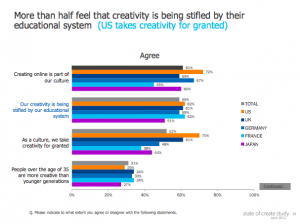We have lost the art of thinking creatively, and it can hurt our chances in career success.
Undoubtedly, STEM (Science, Engineering, Technology, and Mathematics) education is becoming increasingly prevalent. According to a 2016 census by the Government of Canada, several provinces have considerably high percentages of STEM graduates. Among those provinces, Quebec had the highest proportion of STEM graduates (63.2%), while Newfoundland and Labrador, and Alberta closely followed (57.7% and 55.7%, respectively).
Beyond the Bachelor’s Degree
However, STEM students have raised several concerns regarding the current state of education in these fields. A specific issue that was brought up was the lack of focus on the development of critical skills – one of which was creative problem-solving. A 2016 report by Science & Policy Exchange emphasized that critical skills are “transferable across work environments, academic or otherwise, and are therefore vital for success”. Therefore, a deficiency in creative problem-solving skills may prove to be detrimental for a prospective job candidate in STEM disciplines, especially in a job market that grows increasingly competitive each day.
Creative problem-solving skills are not developed overnight; they result from many years of development. Yet, there seems to be less emphasis on this skillset, especially within the school system.

Source: adobe.com
Invention literacy may be the solution.
Invention literacy has the potential to catalyze the development of creative STEM thinkers, but we have to start early.
Jay Silver, the pioneer of the Invention Literacy movement, describes the latter as “the ability to read and write human made stuff, from toaster to apps”. Moreover, there is a “grammar to inventing”, and a “literature of inventions” that can spark the creation of our own inventions. Just as scientists review existing literature to help shape their own studies, inventors can turn to past inventions, such as a car or a hammer, and create something out of it. Invention literacy is the ability to take a piece of man-made object and decompose it to the smallest functional parts.
Jay Silver, pioneer of the Invention Literacy movement, talks about the core concepts of the initiative: observing the surrounding world and redesigning it.
Video: “Hack a Banana, Make a Keyboard!”
Source: ted.com
Creativity starts with observing how the world works – and then changing it.
Invention literacy enables children to redesign the functionality of existing objects. Colleen Graves, a MaKey MaKey advocate, visits and works with numerous schools in developing research projects with the following question: “‘How does ____ work and can I make my own version of it?’” This question motivates children to take ownership of their learning experience. Children are encouraged to use their observations about the world and test out theories of how it works – something that is essential for building up strong STEM thinkers.

Video: “MaKey MaKey – An Invention Kit for Everyone”
Source: youtube.com
Invention literacy encourages everyone to be creative.
Invention literacy also pushes educators to be innovative with their approaches to teaching. For example, learning the fundamental skill of counting money is made more interactive by connecting the MaKey MaKey to a dime, a nickel, a quarter and a penny. It is then used to gather information from the user that is sent to a computer program.
Creative problem skills aren’t only for the resume.
Parents have also seen the firsthand effects of invention literacy – beyond its applications to problem solving. Melissa Taylor, a mother and former elementary-school teacher, described the positive outcomes that resulted from using the MaKey MaKey:
“Not only did my daughter practice her scientific method skills, she also grew a head taller in confidence.”
– Alyssa Gutierrez

4 responses to “Back to the Drawing Board: Creativity and its Role in Science”